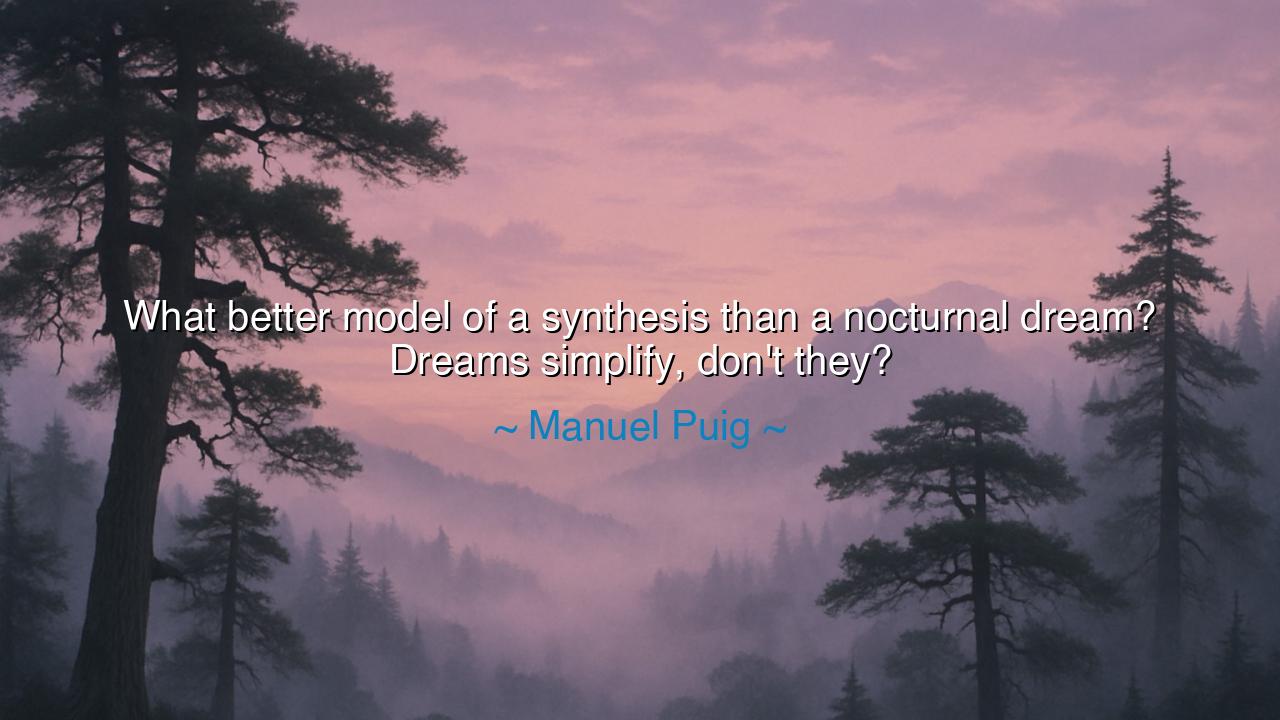
What better model of a synthesis than a nocturnal dream? Dreams






The words of Manuel Puig, the visionary storyteller of passion and paradox, rise like a whisper from the dream-world itself: “What better model of a synthesis than a nocturnal dream? Dreams simplify, don’t they?” In this meditation, Puig reaches into the hidden chambers of the mind, where chaos and clarity dance together, where memory and desire weave a tapestry beyond reason. To him, the dream is not a mere illusion of sleep — it is a sacred synthesis, the meeting place of what is real and what is imagined. In dreams, the many become one; complexity bows before meaning.
In the ancient world, the dream was a message from the divine. The priests of Egypt and the oracles of Greece believed that the gods spoke most truthfully in visions of the night. But Puig, child of the modern age, sees a deeper truth: that dreams simplify because they strip away the noise of daylight thought. When we dream, the mind no longer argues; it synthesizes. It takes the fragments of the day — the fears, the joys, the unsolved riddles — and weaves them into symbols, gestures, and feelings. What seems impossible in waking life finds harmony in the logic of the dream. Thus, the dream is both a simplification and a revelation — a mirror where the soul, no longer bound by reason, speaks its purest language.
Consider the story of Dmitri Mendeleev, the great chemist of Russia, who labored for months to order the elements of nature. Exhausted, he fell asleep at his desk — and in his nocturnal dream, he saw the elements fall into their proper places, forming the Periodic Table. When he awoke, he wrote what he had seen, and the structure of matter was revealed to humanity. Was this mere coincidence, or the work of the subconscious — that deep, silent intelligence that simplifies what waking thought complicates? Mendeleev’s dream was not fantasy; it was synthesis, the uniting of reason and intuition into a single act of creation.
Dreams, then, are the artisans of the spirit. They gather what is scattered. They restore order to confusion and purpose to pain. When Puig calls them a “model of synthesis,” he is teaching that all art — all truth, even — arises from the same power. The novelist, the philosopher, the scientist — each must learn to dream while awake: to take the broken pieces of human experience and forge from them a pattern that makes sense. For only through simplification, through the distillation of what matters most, can one touch beauty and wisdom.
Yet, there is a paradox in Puig’s words. For dreams do not simplify by erasing; they simplify by transformation. They do not deny the pain, the fear, the longing — they transmute them into symbols that the heart can bear. The warrior becomes a bird; the loss becomes a door. In this way, the dream teaches mercy. It shows that within the tangle of life, there lies always a thread of meaning, waiting to be found by those who dare to look inward. This is the alchemy of the nocturnal dream — the turning of confusion into clarity, of multiplicity into one.
The lesson is profound: learn to see the world as the dream sees it. When you are burdened by complexity, seek the synthesis within. Do not drown in details; ask what truth they all point toward. When you face contradiction, look for the unity that hides beneath it. Life is filled with noise, but wisdom lies in simplicity — not the simplicity of ignorance, but the simplicity born of understanding. Just as a dream gathers the fragments of the mind and returns them whole, so must we gather our experiences and draw from them a single flame of meaning.
Therefore, live as the dreamer lives: with eyes half open to the world, and half turned inward to the mystery. Let your imagination be the loom upon which confusion is woven into clarity. Do not fear contradiction; embrace it, for in the act of synthesis lies truth. And remember Puig’s teaching — that in the darkness of the nocturnal dream, the mind becomes its purest self, seeing not with reason but with essence. There, all things are simplified, and all opposites made one. Seek that vision, even in waking life — and you will find, as he did, that the world itself is one vast and living dream.






AAdministratorAdministrator
Welcome, honored guests. Please leave a comment, we will respond soon